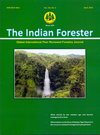Temporal Stability Analysis of Resin Yield of Natural Regenerated Chir Pine (Pinus roxburghii Sargent) in Himachal Pradesh
DOI:
https://doi.org/10.36808/if/2016/v142i4/92322Keywords:
Chir Pine, Finlay and Wilkinson’s Stability Model, Eberhart and Russel’s Stability Model.Abstract
The present investigation entitled 'Temporal Stability analysis of resin yield of natural regenerated Chir pine (Pinus roxburghii Sargent) in Himachal Pradesh.' was carried out during the year 2012-13 with the aim to identify the stable diameter classes with respect to resin yield obtained from Pinus roxburghii. Secondary data on resin yield for 145 trees for seven years w.e.f. year 2005 to year 2011 were taken from the Department of Forest Products, Dr. Y. S. Parmar University of Horticulture and Forestry, Nauni, Solan, Himachal Pradesh. The tree set of 145 trees remain same for all the years. These trees were divided into seven diameter classes i.e. 30-35 cm, 35-40 cm, 40-45 cm, 45-50 cm, 50-55 cm, 55-60 cm and 60-65 cm depending upon the variability among data. Two stability models viz. Finlay and Wilkinson's model (1963) and Eberhart and Russell's model (1966) were used to identify the stable diameter class for the production of resin. Pooled analysis of variance was performed to detect the presence of diameter class (D) × year (Y) interaction. The effects due to Y, D and D × Y interaction were found to be significant. Finlay and Wilkinson's model suggested that the diameter class 40-45 cm had the mean (D) greater than the overall mean and regression coefficient bi was nearly equal to one. Eberhart and Russel's model indicated that the diameter class 40-45 cm had (0.35) which 2 was greater than zero, regression coefficient bi (0.872) which was nearly equal to one and low (s d). Thus, diameter i class 40-45 cm was identified as stable diameter class with respect to resin yield obtained from Pinus roxburghii. Therefore, it may be concluded that diameter class 40-45 cm was most stable for resin yield.References
Eberhart S.A. and Russell W.L. (1966). Stability parameters for comparing varieties. Crop Science, 6(1): 36-40.
Finlay K.W. and Wilkinson G.N. (1963). Analysis of adaption in a plant-breeding programme. Aust. J. Agric. Res., 14:742-54.
Joshi H.B. (1972). Lowering of minimum diameter for resin tapping in chir (Pinus roxburghii). Indian Forester 98(1):441-448.
Noh E., Koo Y. and Lee S. (1997). Selection of Populus davidiana dode clones using stability analysis. Research Report of the Forest Genetics Research Institute Suwon, 33(1): 1-13.
Raiger H.L., Dua R.P., Sharma S.K. and Phogat B.S. (2011). Performance and stability of jatropha (Jatropha curcas) for seed yield and its components. Indian J. Agricultural Sciences, 81(2):125-128
Sahni K.C. (1990). Gymnosperms of India and adjacent countries. Bishan Singh Mahendra Pal Singh, Dehradun. Pp. 1-169
Song Y., Zhang Hang and Ming Sheng (1997). Study on genotypic stability in loblolly pine. Forest Research, 10(6): 581-586.
Wang KeSheng, Bian XueYu, Li ShuMei, Tong YongChang and Han YiFan (1996). Analysis on effect and stability of the regional test of Populus × euramericana clones. Forest Research, 9(1):92-96.
Downloads
Downloads
Published
How to Cite
Issue
Section
License
Unless otherwise stated, copyright or similar rights in all materials presented on the site, including graphical images, are owned by Indian Forester.





